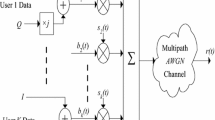Abstract
Third generation mobile radio systems will employ TD-CDMA in their TDD mode. In a TD-CDMA mobile radio system, joint-detection is equivalent to solving a least squares problem with a system matrix that exhibits some form of block-Toeplitz structure. This structure can be successfully exploited by using variations of the Schur algorithm for computing the QR decomposition of this system matrix. Together with a displacement representation, the Schur algorithm can be straightfonvardly adapted to a wide variety of matrix structures. In this paper we show this approach for two concrete manifestations of the TD-CDMA system matrix : first for a very compact, block-Toeplitz structure ; and second for the less favorable Toeplitz-block structure that arises when decision feedback is added to the data detection process.
Résumé
Le système de radiocommunication avec les mobiles de troisième génération emploierait l’accès multiple par répartition mixte en code et en temps (TD-CDMA) dans leur mode de duplexage temporel (TDD). Dans un tel système, la détection conjointe des utilisateurs est équivalente à la résolution d’un problème de moindres carrés où la matrice du système présente une certaine forme de structure de Toeplitz en blocs. Cette structure peut être exploitée avec succès en utilisant des variations de l’algorithme de Schur pour calculer la décomposition QR de la matrice. Combiné à une représentation du déplacement, l’algorithme de Schur s’adapte directement avec une grande variété de structures matricielles. L’article applique cette approche à deux exemples concrets de matrices : une structure de Toeplitz en blocs très compacte ; une structure en blocs de Toeplitz moins favorable qui résulte de l’adjonction d’un retour des décisions de détection des données.
Similar content being viewed by others
References
Jung (P.), Blanz (J. J). Joint detection with coherent receiver antenna diversity in cdma mobile radion systems,IEEE Trans, on Vehicular Technology,44, pp. 76–88, (1995).
Jung (P.), Blanz (J. J), Baier (P. W). Coherent receiver antenna diversity for cdma mobile radio systems using joint detection, in Proc. 4th IEEE Int. Symp. on Personal, Indoor and Mobile Radio Commun. (pimrc), Yokohama, Japan, Sept. 1993, pp. 488–492.
Blanz (J. J), Klein (A.), Nabiian (M.), Steil (A). Performance of a cellular hybrid c/tdma mobile radio system applying joing detection and coherent receiver antenna diversity,IEEE J. Select. Areas Commun.,12, pp. 568–579, (May 1994).
Ottosson, (T.). Coding, modulation and multiuser decoding for DS-CDMA systems,Ph. Z. thesis, Chalmers University of Technology, Göteborg, Sweden, (1997).
Blanz (J. J), Klein (A.), Nabhan (M.), Andreas Steil (A.). Performance of a cellular hybrid c/tdma mobile radio system applying joing detection and coherent receiver antenna diversity,IEEE Journal on Selected Areas in Communications,12, no 4, (May 1994).
Mayer (J.), Schlee (J.), Weber (T.). Realtime feasibility of joint detection cdma, in Proc. 2nd European Personal Mobile Communications Conference, Bonn, Germany, Sept. 1997, pp. 245–252.
Steiner (B.), Jung (P.). Optimum and suboptimum channel estimation for the uplink of cdma mobile radio systems with joint detection,European Trans, on Telecommunications and Related Techniques, vol.5, pp. 39–50, 1994.
Luenberger (D.G.). Optimization by vector space methods, John Wiley and Sons, New York, NY, (1969).
Golub (G. H.), van Loan (C. F.). Matrix computations. The John Hopkins University Press, third edition, 1996.
Kailath (T.), Chun (J.). Generalized displacement structure for block-Toeplitz, Toeplitz-block, and Toeplitz-derived matrices,SIAM J. Matrix Anal. Appl,15, no 1, pp. 114–128, (January 1994).
Götze (J.), Park (H). Schur-type methods based on subspace criteria, inProc. IEEE Int. Symp. on Circuits and Systems, Hong Kong, 1997, pp. 2661–2664.
Chun (J.), Kailath (T.), Lev-Ari (H.). Fast parallel algorithms for QR and triangular factorization, SIAM J. Sci. Stat. Comput., 8, no 6, (November 1987).
Author information
Authors and Affiliations
Corresponding author
Additional information
Marius Vollmer works on his PhD thesis both at the University of Dortmund and at Siemens AG.
Rights and permissions
About this article
Cite this article
Vollmer, M., Haardt, M. & GÖtze, J. Schur algorithms for joint-detection in TD-CDMA based mobile radio systems. Ann. Télécommun. 54, 365–378 (1999). https://doi.org/10.1007/BF02997759
Received:
Issue Date:
DOI: https://doi.org/10.1007/BF02997759
Key words
- Mobile radiocommunication
- Code division multiple access
- Time division multiple access
- Signal detection
- Complex signal
- Least squares method
- Matrix method
- Toeplilz matrix
- Matrix decomposition
- Decision feedback
- Algorithm complexity




